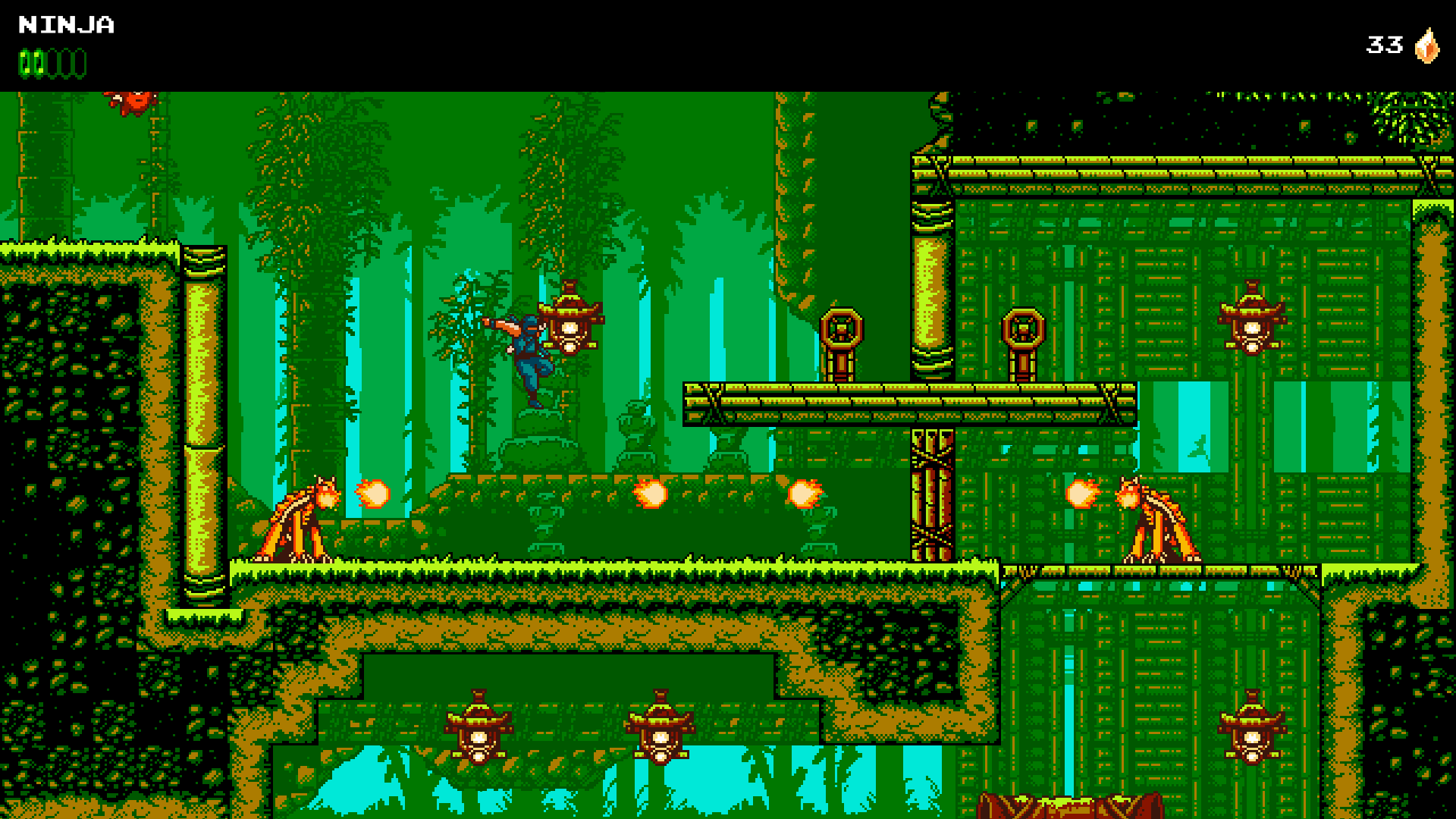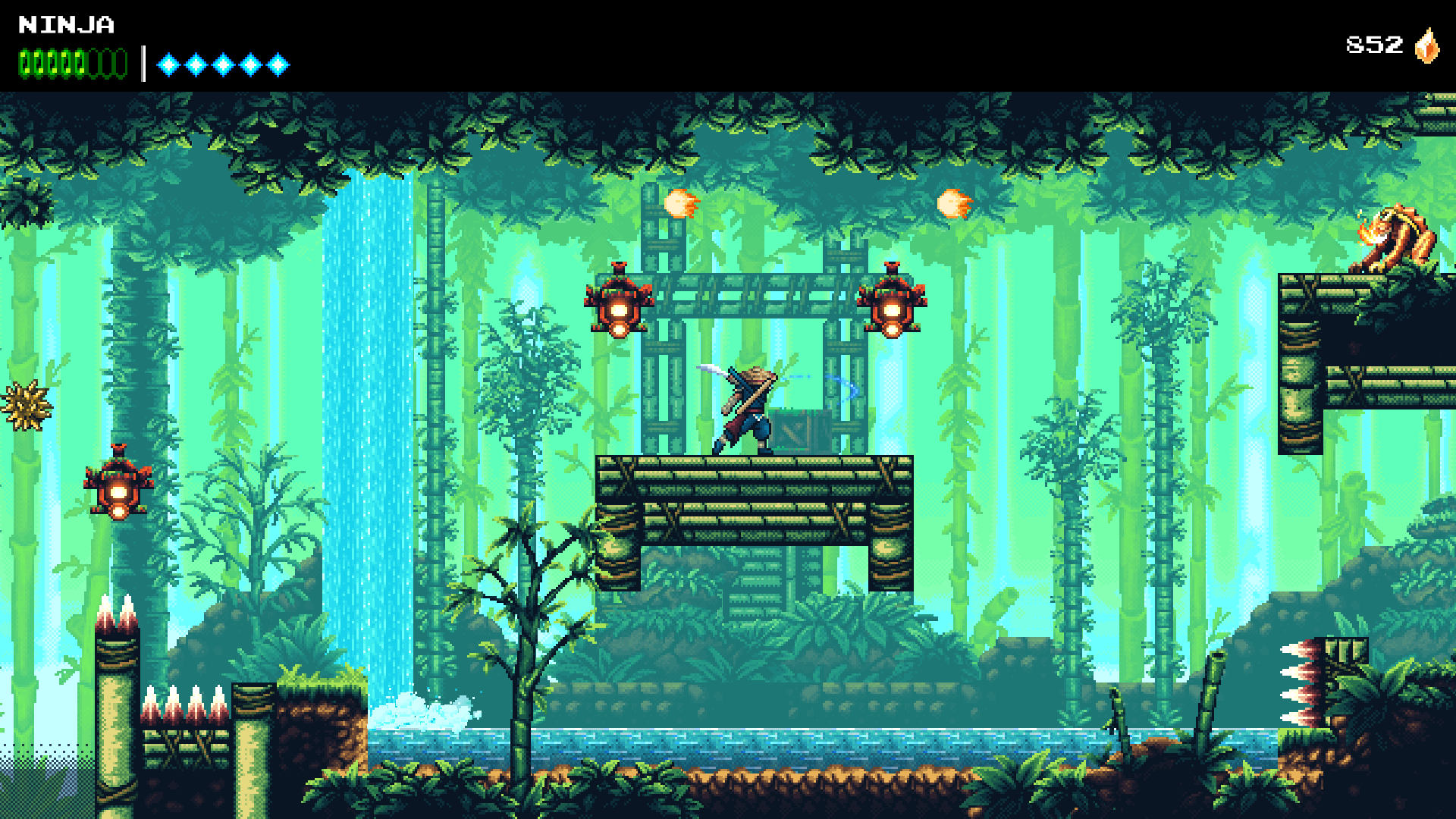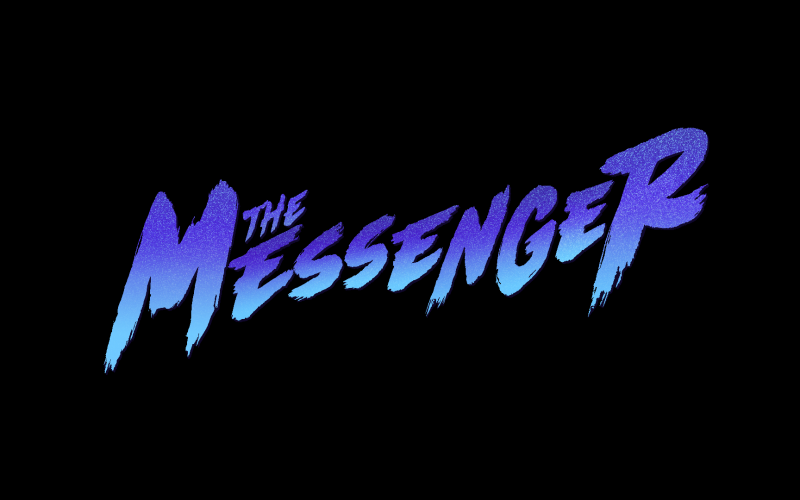If there is one thing I love more than indie games paying tribute to NES games is indie games paying tribute to SNES games! This will always be my bias with SNES being the console I have the most fond memories of. I’m happy with having NES or SNES inspired games, but imagine my surprise when The Messenger decided to give me both of them!
Developer: Sabotage
Platform: Nintendo Switch
Release date: Aug 30, 2018
Price: $19.99
In this game you play as The Messenger, a hero tasked with taking the scroll to the far reaches of the island. Your journey will take you through varied landscapes like snowy mountains and bamboo forests. Throughout your journey you will also meet some interesting characters like the shopkeeper who illustrates the history of the world.
1 game, 2 eras
Before going into more details about the game, I want to discuss the main gimmick of this game because it is so amazing and fundamental to the rest of the review. After a certain point in the game, you learn to time-travel. Rather than traveling to a future that is vastly a different world, The Messenger decides to take you to the future of consoles. Yep, you go from being an 8-bit game into a 16-bit game, all sprite work and even music changes included. Yes, you also get different scenery and platforming, but being able to switch to 16 or 8-bit is way too fantastic. It feels like skipping to a sequel and then back for nostalgia and it works incredibly well!

The irony is that I think this twist would have been 100x more fantastic if it wasn’t heavily advertised on the trailers. I was hoping for the longest time to reach the 16-bit transition part of the game, but once I got into the story I realized that it would have been a jaw-dropping discovery had I not known about it. To be fair, it also would have meant a huge undermining of the marketing of the game, and it becomes such a huge feature of the latter half of the game that it deserved being in the pre-release spotlight.
Other than changing the aesthethic of the game, the inclusion of time travel vastly changes how the second half of the game plays, so for the sake of it I’ll try and separate them into their own mini reviews.
Be the ninja
Perhaps one of my favorite things about The Messenger is how good it plays. If you saw the trailers and thought it was a game like Ninja Gaiden, then I’m glad to say you are right in thinking that. Your base moveset feels like it was taken straight from Ryu Hayabusa. You can run, jump and slash your sword through the multitude levels while retaining maximum control of your characters and its jump trajectory. The Messenger gives you so much control that you will never think that you died because of the game’s fault.
Of course, the movement becomes much more refined with the inclusion of the cloudstep technique. If you attack and enemy or object during your jump, you will see a cloud beneath your feet that allows you to do an air jump. It only allows for one jump, but you can hit anything to gain more and more cloudstep jumps. While it may sound like a simple concept, it allows for some seriously fun platforming and even more advanced movement for speedrunners and hardcore players.

The game never requires you to perform something more than basic cloudsteps, so it doesn’t gate progression for newer players but it does add an extra layer of refinement for the advanced and returning player. You might have missed something on your first playthrough, but by the time you dive back into the game you will find out that you can reach the high platform with some creative thinking.
As you advance through the game, you start to understand why it is also classified as a metroidvania. As you play through the levels you will start to gain new abilities that allow you to progress further. This abilities range from stuff like a raccoon suit, which is basically the gliding ability, all the way to genre staples like a grappling hook (it isn’t called like this, but the game acknowledges it will be called that way so I just comply). Thanks to this new abilities you can start taking detours on each stage and collect green power coins.
A classic NES experience
During your first half of the game, you will feel like these new abilities would have been awesome in the earlier levels, but you have no way of going back. That’s because the first half of the game plays in a linear fashion with each stage being different from the last. Backtracking is not an option because the game expects you to advance each level like in the old NES games without looking back. The challenge is there, but also the feeling of relief when you finally make it out of that annoying level which gave you trouble.
The only way to break through the progression is to enter one of the many shops scattered throughout the stages. In here you meet the shopkeeper, which is a mysterious fellow that aids you in your journey. The shopkeeper will sell you upgrades and also give you information in regards to your surrounding.

At this point I have to say that the shopkeeper is by far my favorite character in the game. His humor is always spot on and more often than not I found myself going to the shop to see if new dialogues opened with the shop keeper. In regards to useful information, he will tell you about the level you are currently navigating and even talk about the boss on the last stop before each fight. But the best thing is asking him to tell you stories. These stories are in no way related to the game, but are pretty funny to hear nonetheless! Some even discuss classic stories but with a black humor twist like The princess of the pea.
The shopkeeper will also sell you upgrades for a price. The price are the timeshards that will be scattered on each level. Think of them as the coins in Mario and how they are placed in a matter than encourages you to go through not obvious routes. The upgrades range from increasing your HP to unlocking moves like the charged attack. Unfortunately, I think the available powerups are too few and easy to acquire, which meant that at a very early point in the game I was already amassing huge amounts of currency.
Traveling to a different era
The game massively expands once you first unlock time travel. Via some clever twist, you now discover that each level you went through is linked and this marks the beginning of the metroidvania part of the game. At this point you are tasked with backtracking and finding the 8 musical notes to unlock the final level.

At first this would sound like a very lazy fetch quest, but it is kept from being that thanks to the 16-bit transition. Going through the same levels you already cleared becomes a refreshing experience because you can now view them in 16-bit. The enemy location and platforms are also changed, which allows each level to be different. The style can be changed from 8 to 16 or vice-versa thanks to portal which open up in every stage and make way for some clever puzzles.
The best comparison I can find to this is with Metroid Prime 2: Echoes. The 8-bit and 16-bit world remind me a lot of when I was going through light and dark world to make my way to the next objective. Unlike Metroid Prime 2, the transition is pretty seemless in The Messenger and the way the music changes is probably my favorite part of the game!
Locks and keys
With all the hype surrounding the metroidvania portion of the game, I have to admit that I consider it by far the weakest part of the game. Apart from connecting each level you already cleared, you are also given new paths to unlock new areas and also get to explore that room you weren’t able to reach on your first go at the stage, so what went wrong if it complies with some elements of a good metroidvania?
I think the biggest reason for this is that all the game enhancing power-ups were unlocked in the first half of the game. The rest of the game will have you go through the same old maps clearing new quests by playing with the past and future mechanic. Unfortunately, the power-ups that are unlocked do not expand upon the gameplay and serve as glorified keys. The only exception to this is the lightfoot tabi, which feels like the only extra move you gain from the second half of the game.

Without new moves, there is also little incentive to keep exploring the map other than to advance the story and collect power coins. Perhaps that isn’t entirely true, as there was a huge incentive to replay every map when time travel was unlocked and you were able to play the first stages with a complete moveset. The issue arises from the pacing, and how you must backtrack through the levels multiple times to finish collecting the music notes. Eventually you reach a point where you’ve gone to the bamboo forest multiple times and even dread having to go back there.
the prophecy
The only orientation you are offered as to where you should go next comes from the prophecies. These prophecies serve as mini-puzzles that give you hints as to where you should go next to progress the story. Some prophecies will make a lot of sense, others will feel like a trial and error lap through the entire game to see if you make any sense of it. Luckily you can also purchase clues and even the exact location from the shopkeeper, provided you want to spare some cash. I guess that’s a fair trade, as previously I mentioned how money piles up very fast once you purchase all upgrades.
In contrast to everything I said before, the new areas that unlock after finish solving the prophecy puzzle are pretty fun. They also take full advantage of the entire ninja moveset and time travel, which offers some really fun platforming challenges and boss fights!
I mentioned how most of the later power-ups feel like keys, but that doesn’t keep them from having a lot of character! My favorite item is definitely the magic seashell. At the beginning it doesn’t make any sense, but when you do realize where it’s useful and the neat effect it borrows from another legendary game, then I dare you not to smile in happiness!
Last words
Overall I think The Messenger is a fantastic game. From beginning to end it caught me with a grip that didn’t let me put the game down for a second! It is very hard to find games which are so captivating when you reach a certain age where time is precious. The Messenger was all I hoped it to be from the trailer and maybe even more. The slickness of the movement also screams for me to speedrun it, so that’s going to give it a bunch of longevity, but for the rest of the people it will still amount to some of the best 10-15 hours of gaming you’ll spend this year.
Also, the ending sequence is fantastic!

